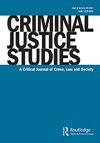Mediating the victim–offender overlap with delinquent peer associations: a preliminary test of the person proximity hypothesis
IF 1.1
Q3 OPERATIONS RESEARCH & MANAGEMENT SCIENCE
引用次数: 10
Abstract
ABSTRACT The principal goal of this study was to identify the mechanisms responsible for the victim-offender overlap. Participants were 1,354 (1,170 males, 184 females) youthful offenders (mean age = 16.04 years) from the Pathways to Desistance study. The path running from violent offending to violent victimization was tested for mediation using peer delinquency and unsupervised routine activities as mediators, whereas the path running from violent victimization to violent offending was tested for mediation using peer delinquency and depression as mediators. Congruent with the first research hypothesis, peer delinquency mediated the violent offending–violent victimization pathway and did so significantly better than unsupervised routine activities. Contrary to the second hypothesis, peer delinquency did not mediate the violent victimization–violent offending pathway. The role of person proximity and peer selection in linking violent offending to future violent victimization is discussed.调解受害者-罪犯与犯罪同伴协会的重叠:对人接近假说的初步检验
摘要本研究的主要目的是确定被害人与犯罪人重叠的机制。参与者为1354名(1170名男性,184名女性)青少年罪犯(平均年龄=16.04岁),来自“放弃之路”研究。使用同伴犯罪和无监督的日常活动作为中介,对从暴力犯罪到暴力受害的路径进行了调解测试,而使用同龄人犯罪和抑郁症作为中介,测试了从暴力受害到暴力犯罪的路径。与第一个研究假设一致,同伴犯罪介导了暴力犯罪-暴力受害途径,并且比无监督的日常活动做得更好。与第二个假设相反,同伴犯罪并没有介导暴力受害——暴力犯罪途径。讨论了人的接近和同伴选择在将暴力犯罪与未来暴力受害联系起来方面的作用。
本文章由计算机程序翻译,如有差异,请以英文原文为准。
求助全文
约1分钟内获得全文
求助全文
来源期刊

CRIMINAL JUSTICE STUDIES
OPERATIONS RESEARCH & MANAGEMENT SCIENCE-
CiteScore
2.80
自引率
5.60%
发文量
17
期刊介绍:
Criminal Justice Studies, a quarterly refereed journal, publishes articles that deal with substantive criminal justice and criminological issues. The journal welcomes all articles that are relevant to the issue of criminal justice, as well as those that may be outside the field but have relevancy to the topic of criminal justice. Articles that cover public administration, issues of public policy, as well as public affairs issues are welcome. The journal also publishes relevant literature reviews, research notes and summary reports of innovative research projects in criminal justice. Qualitative and quantifiable articles are sought mainly from academics and researchers in the field, though articles from professionals will also be considered.
 求助内容:
求助内容: 应助结果提醒方式:
应助结果提醒方式:


